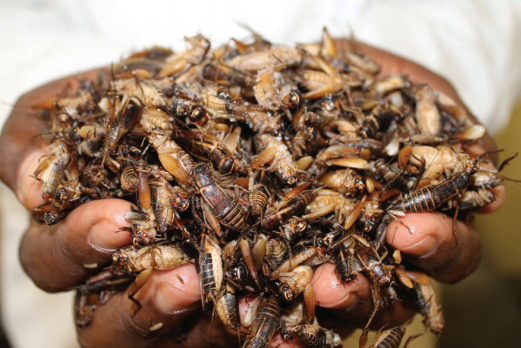Much has been said about cricket farming. Some have even christened it “the game-changer” in Kenya’s food and agriculture sector. Media platforms are awash with success stories of farmers who “discovered gold” by rearing a handful of these orthopterous insects. But is this just another one of those over-hyped business ideas that end up dissapointing investors? Or are there opportunities to be explored at this stage? We take a closer look at the concept of cricket agri-business; the opportunities and challenges it poses.
Cricket Farming in Kenya
Crickets are dark insects that produce a certain sharp noise at night. You probably are familiar with them already if you were brought up in the rural areas. Well, according to research, their meat is more nutritious than beef and even soybeans.
| Food | Protein Content (per 100grammes) |
|---|---|
| Beef | 36/100 |
| Soybeans | 49/1000 |
| Cricket | 60/100 |
| Almonds | 21/100 |
| Fish | 20/100 |
| Chicken | 29/100 |
| Eggs | 13/100 |
| Yoghurt | 5.7/100 – Source |
The Association of Dutch Insect Farmers (VENIK) lauds crickets as a viable option for solving widespread cases of malnutrition and kwashiorkor.
The good thing about this insect is that you can capture it in the wild and rear it in a closed set-up. It typically takes a few weeks for adult females to start laying eggs which you can then use to expand your farm.
A youngling takes about 3 months to mature after which it can be sold for Ksh7. A typical 3m x 4m crate (which is recommended for farming these insects) houses 100 crickets. That translates to Ksh700 revenue per crate.
Thus, a small piece of land (say 40ft x 20ft) can accommodate over 100 crates which potentially represent Ksh70,000 that can be made in 3 months – which is quite profitable. Compare this to sorghum farming which rakes in Ksh16,500 per acre in 4 months.
How to Get Started
You need about Ksh1,000 to start a small farm. With that amount you can purchase the following items to catch around 50 crickets from the wild to start your farm.
| Unit | Amount |
|---|---|
| Basin/Bucket | Ksh150 |
| Net (for covering the basin) | Ksh20 |
| Vegetable or chicken mash | Ksh50 |
| Soil | Free |
| Cotton | Ksh20 |
| Two tray eggs | Ksh400 |
| Other Expenses | Ksh350 |
| TOTAL | Ksh1,000 |
Once you capture your first batch of crickets, you will go ahead and feed them with food leftovers and greens until they start producing eggs. Keep this cycle going until you have enough crickets all over the farm after which you can start supplying (them) to the market either in raw or processed form.
Are There Enough Cricket Eaters in Kenya?
The jury is still out on whether Kenyans are warming up to this new eating trend or not. From our research we found a lot of interest about cricket farming in Nyanza regions and some parts of Uganda. There are also hotels in Nairobi that serve meals that are fortified with cricket powder. A medium-sized cake fortified with this powder goes for Ksh500 according to the Business Daily Newspaper.
Is It A Good Idea?
Just like quail rearing, this idea has the potential to become another stuck ship if overdone. The consumption pattern on the ground does not justify mass production of crickets. On a positive note, there are still wide opportunities here yet to be explored. With value addition, public-sensitization and intelligent targeting of the market, this can turn out to be such a great business idea. It’s indeed true to say that you can grow your Ksh1,000 to Ksh70,000 in 3 months – but that will certainly not come on a silver platter. You need to roll up your sleeves to get to the heart of this. Otherwise, this is an interesting idea to ponder upon.



















